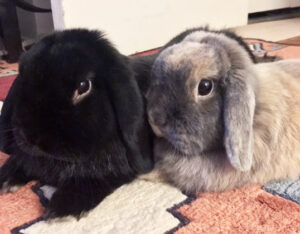Patient Spotlight: Cataract Surgery Restores Vision for Rabbits

When Min Park adopted Holland lop rabbits Bossy Pants and Cocoa Bean from a shelter in New York City around Valentine’s Day, she was just looking for some bunnies to love. But within a year of their “adoptiversary” her rabbits would go blind.

What began as a little cloudiness in one of Cocoa Bean’s eyes quickly progressed to full blindness in both eyes. Never one to be left out, Bossy Pants also became fully blind within six months of her companion.
The rabbits, just under 3 years old, were both diagnosed with bilateral advanced cataracts by their veterinarian in New York. A condition that is more common for older rabbits, cataracts refer to opacification of the lens of the eye. The lens is a transparent eye structure that focuses light on the retina, creating a sharp image for the rabbits to see. When the lens becomes opaque or cloudy, vision becomes blurry. Since the entire lens was affected, both rabbits were blinded by the cataracts.
Unwilling to resign Bossy Pants and Cocoa Bean to a life of blindness, Park began researching her options. She read everything she could find on rabbits with cataracts and worked with a team of exotic veterinarians in her area to determine the best care options. During her research, she read an article online detailing a cataract surgery performed on the author’s rabbit at the NC State Veterinary Hospital.
After talking with Hans Westermeyer, assistant professor of ophthalmology and the same clinician from the article, Park scheduled an appointment with the NC State Veterinary Hospital’s exotics and ophthalmology services.
“After calling almost every single reputable exotics and veterinary university that would consider rabbit cataract surgery, I could just tell after speaking with the team at NC State that I was making the right decision,” Park said.
The Eye-deal Situation
Any car ride from New York to North Carolina is challenging, but bringing along multiple pets and carrying the stress of possible surgery is more daunting. So Park and her boyfriend decided to turn the eight-hour road trip into an adventure.
“Fortunate for us, our buns love car rides!” Park said.
To make the trip more comfortable for the rabbits, she lined the floorboard in the back of her car with a fluffy blanket, litter and hay. With beautiful weather, some fun music and a few extra stops, the family arrived in Raleigh in no time.
At the hospital, the rabbits were examined to make sure cataract surgery was the best option. An electroretinogram evaluated how well the retinas, the structure at the back of the eye containing cells responsible for vision, were functioning. If the retina is not functioning well prior to surgery, then removing cataracts may not restore vision. An ocular ultrasound was also performed to view the ocular structures behind the lens. This allowed Westermeyer to determine if there was damage to the back of the lens and assured him that the retina was in the correct anatomic location.

Once the rabbits were deemed ready for surgery, Westermeyer removed the cataracts using phacoemulsification. The eyes were prepped with saline solution before small incisions were made into the edge of the cornea, the transparent dome-shaped layer of the eye that covers the iris and pupil and helps refract light.
The phacoemulsification needle, a small pen-shaped probe, was inserted into the eye through the incision and used ultrasonic vibrations to break up the cataract. Once all of the cataract was removed, a permanent artificial lens was inserted into place through the small corneal incision. The new lens allows light to be focused properly on the retina, restoring crisp, focused vision. All four artificial lens implantations were successful and the corneal incisions were closed with very thin sutures to complete the surgeries.
“Everyone was above and beyond knowledgeable, patient and warm,” Park said. “There was no way we could have found the same level of doctors with such extensive experience back home, as we researched endlessly. We couldn’t have asked for a better team to facilitate this surgery for our bunnies. We continue to sing their praises as it made all the difference between good and amazing.”
An Eye-Opening Experience
After recovering at the hospital overnight, Bossy Pants and Cocoa Bean were ready to go home. Park and her boyfriend prepped their car for the recovering rabbits and loaded them up for the trip back to New York.
Instead of driving back and forth to North Carolina for checkups, the NC State team worked with Park’s veterinarian in New York to ensure a smooth recovery.
“The recovery and all follow-ups have been excellent,” Park said. “Everyday we watch them we are amazed that they went from blind and limited to full vision and thriving.”
To learn more about the exotics service, visit their web page.
~Brittany Sweeney/NC State Veterinary Medicine
- Categories:


